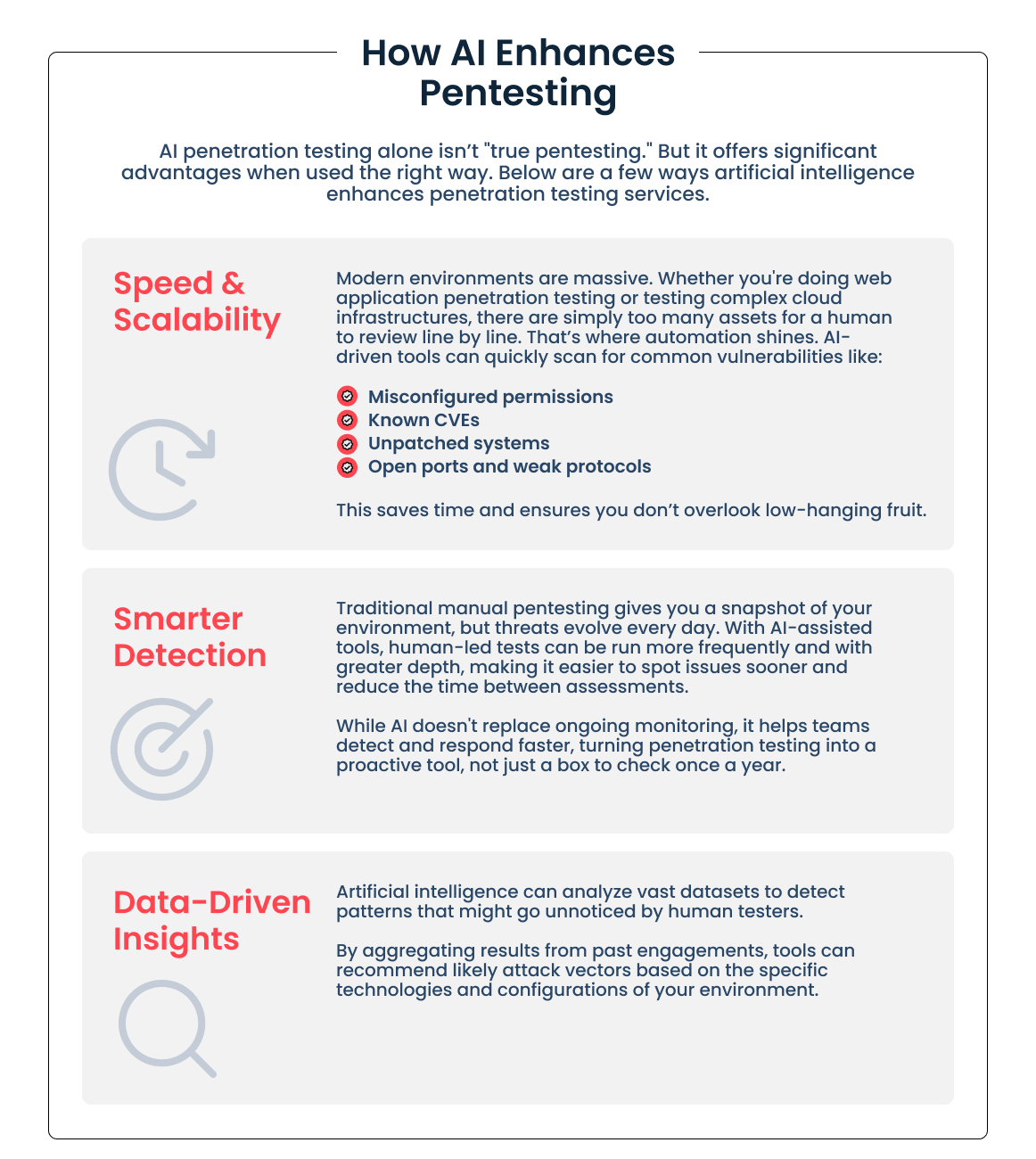Human-Led AI Pentesting: The Future of Cybersecurity Has Both Brains & Bots
The cybersecurity threat landscape is evolving fast, and so are the tools we use to defend against it. As attackers get more sophisticated, defensive strategies have had to level up. Enter human-led AI pentesting: a modern approach that blends the speed and scalability of artificial intelligence with the strategic insight and intuition of human experts.
At Red Sentry, we believe the future of penetration testing lies in combining the best of both worlds. Automation enhances our work, but it doesn't replace it. Here's why this hybrid model isn’t just a trend—it’s a transformation.
What Is Human-Led AI Pentesting?
Human-led AI pentesting refers to a testing methodology that uses artificial intelligence to augment traditional manual pentesting processes. Automated tools handle high-volume, repetitive tasks, like scanning large environments for known vulnerabilities, while expert pentesters focus on analyzing business logic flaws, chaining exploits, and simulating advanced real-world adversaries.
Think of it this way: AI handles the heavy lifting, like sorting through data and scanning systems. The human pentester steps in to verify and investigate further.
Used together, they create a faster, smarter, and more accurate penetration testing process—one that goes beyond checklists and truly challenges your defenses.
How AI Enhances Pentesting
AI penetration testing alone isn’t "true pentesting." But it offers significant advantages when used the right way. Below are a few ways artificial intelligence enhances penetration testing services.

Speed & Scalability
Modern environments are massive. Whether you're doing web application penetration testing or testing complex cloud infrastructures, there are simply too many assets for a human to review line by line. That’s where automation shines. AI-driven tools can quickly scan for common vulnerabilities like:
- Misconfigured permissions
- Known CVEs
- Unpatched systems
- Open ports and weak protocols
This saves time and ensures you don’t overlook low-hanging fruit.
Smarter Detection
Traditional manual pentesting gives you a snapshot of your environment, but threats evolve every day. With AI-assisted tools, human-led tests can be run more frequently and with greater depth, making it easier to spot issues sooner and reduce the time between assessments.
While AI doesn't replace ongoing monitoring, it helps teams detect and respond faster, turning penetration testing into a proactive tool, not just a box to check once a year.
Data-Driven Insights
Artificial intelligence can analyze vast datasets to detect patterns that might go unnoticed by human testers. By aggregating results from past engagements, tools can recommend likely attack vectors based on the specific technologies and configurations of your environment.
Why Human Insight Still Matters
Despite the advantages of AI pentesting, there are limits to what automation can do on its own. The biggest risk? Mistaking breadth for depth.
Business Logic Vulnerabilities
No AI can fully understand your business. That means it often misses logic flaws; in other words, vulnerabilities that arise from how your applications are designed to work. For example:
- Can a user bypass a payment screen by modifying a URL?
- Can someone escalate privileges by tampering with session tokens?
These flaws are the kinds of issues a seasoned pentester is trained to find.
Exploit Chaining and Contextual Attacks
AI might report 50 low-priority issues. A human can see how those issues chain together into a critical exploit. For instance, combining an exposed API, a weak password reset flow, and a misconfigured role could result in admin-level access.
Human-led analysis gives the context that automation lacks. It helps separate signal from noise and prevents teams from chasing false alarms.
Bypassing AI Evasion Techniques
Attackers are already adapting to automated security tools. Some use AI evasion techniques, such as introducing minor payload variations or obfuscating code, to dodge detection. Human testers can recognize these tactics and adjust in real time—something no script or scan can do.
AI Tools In Action: What They’re Good At
AI-powered tools in the penetration testing space are getting smarter. Here’s where they shine:
- Reconnaissance: Automated tools excel at asset discovery and OSINT gathering across public and dark web sources.
- Fuzzing: Automated input testing helps detect unexpected behaviors in web apps and APIs.
- Credential stuffing simulations: AI can test large datasets of leaked credentials against login portals.
- Log correlation: Tools can help identify signs of lateral movement or anomaly patterns across systems.
When integrated into a human-led pentesting service, these capabilities free up human experts to focus on higher-order tasks.
Why Human-Led AI Pentesting Wins
Many companies today are forced to choose between expensive, time-consuming manual pentests or fast, lightweight AI penetration testing tools that may lack depth.
But why not both?
Human-led AI pentesting offers the best of both worlds:
- Efficiency without sacrificing accuracy
- Automation without losing context
- Scalability with real-world relevance
It’s how modern organizations strike the balance between continuous risk detection and meaningful remediation. And for companies with growing digital footprints, it’s not just a nice-to-have. It’s essential.
What This Means for Web Application Pentesting
When it comes to web application penetration testing, combining automation with human expertise is especially powerful. AI tools can quickly scan input fields, APIs, and cookies for known vulnerabilities like SQL injection or XSS. Human testers, on the other hand, dig deeper, and ask the following questions:
- Can a user break the app’s intended flow?
- Are error messages revealing sensitive info?
- Can session behavior be exploited for access escalation?
This hybrid approach is faster, smarter, and more effective at finding real risk in your apps before attackers do.
How Red Sentry Is Utilizing AI Moving Forward
The debate between AI pentesting and manual pentesting is outdated. The real conversation is how we combine the strengths of both.
At Red Sentry, we believe human-led AI pentesting is the future of offensive security. Our expert pentesters use automation to enhance (not replace) their work, enabling faster engagements and more accurate results. Whether we’re testing a client’s internal network or simulating attacks on a customer-facing app, we layer intelligent automation into every phase of the process.
Want to see how true pentesting works with human insight and machine power? Contact Red Sentry to schedule your next engagement.











